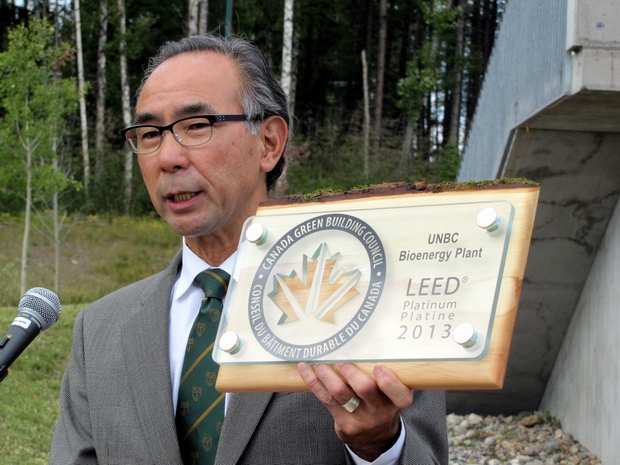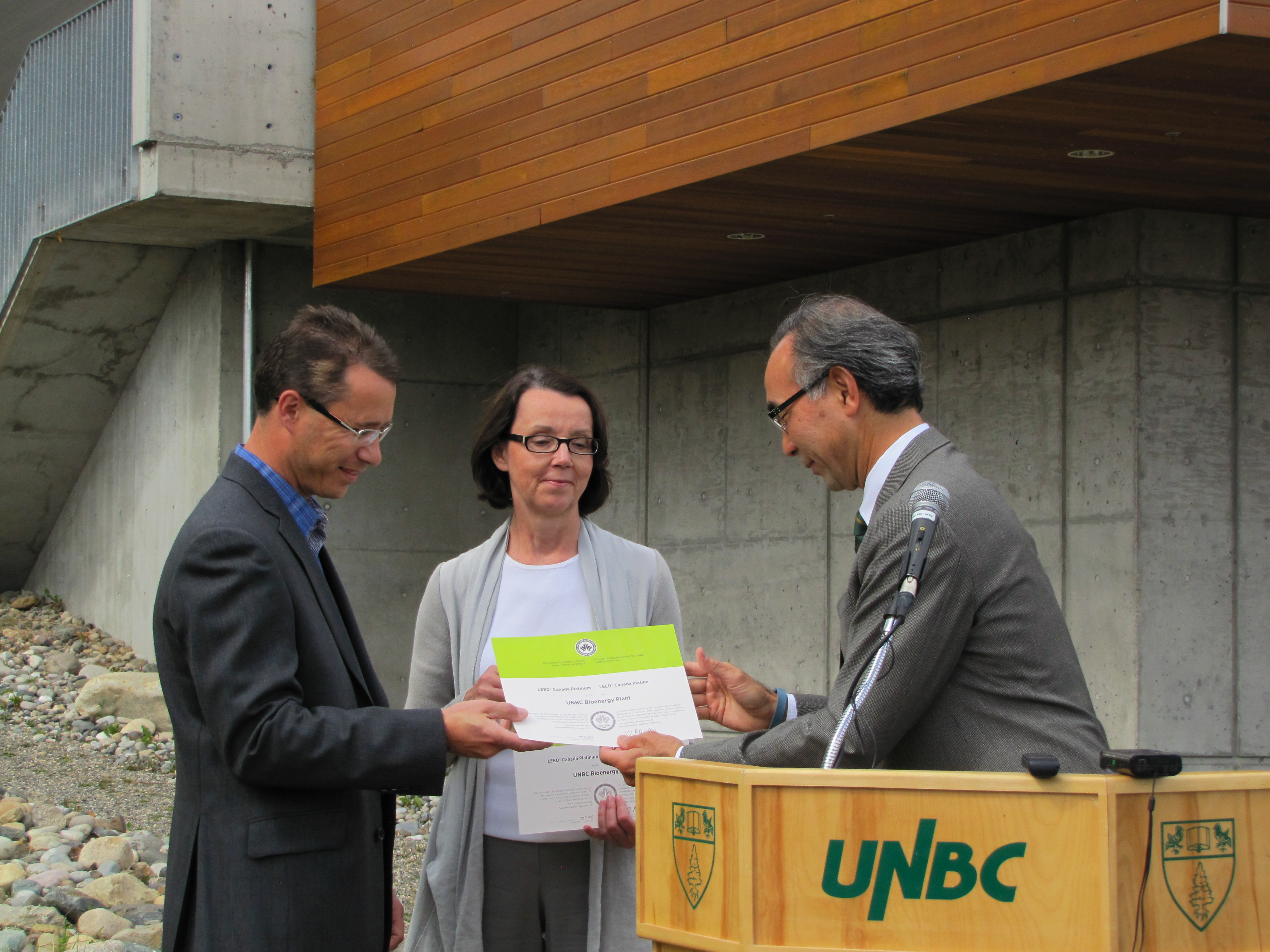UNBC’s Bio Energy Plant Receives Highest LEED Certification
Wednesday, August 28, 2013 @ 2:27 PM

UNBC President Dr. George Iwama, displays LEED Certification plaque – photo-250News
Prince George, B.C. – UNBC can now boast that it is the first university in British Columbia to have a building rated as LEED Platinum (Leadership in Energy and Environmental Design) , the highest environmental standard possible for construction. The certification is for the Bio Energy plant at UNBC. It is means UNBC is only the fourth university in all of Canada to have a building with such a high rating.
“We are exceptionally proud of having achieved this certification and of our continued commitment to sustainability at UNBC,” says UNBC President George Iwama who says it a great accomplishment for Northern BC.
The plant came on stream in March of 2011. In 2012, the plant produced 62,000 gigajoules of energy, offsetting nearly 90% of UNBC’s fossil fuel use needed to heat buildings connected to the energy system.
It was IDL Projects Inc of Prince George which built the bio-energy plant, and IDL President Dennis Schwab says from the very beginning the plan was to exceed the set targets “We diverted more than 38 tonnes of waste from the landfill; used metals, concrete, insulation, and gyproc with post- and pre-waste content; and more than 20% of building materials, including glue-laminated lumber, concrete, aggregate, gyproc, rebar and forming lumber, were sourced regionally.”
Designed by Karen Marler of Hughes Condon Marler Architects, she says UNBC wanted this to be more than an industrial building, “It needed to achieve LEED Gold, and it needed to be beautiful.”

In the end, the project exceeded LEED Gold, and has been graded at the top of its class with LEED Platinum certification.
( at right, Iwama presents LEED Platinum certificate to Dennis Schwab and Karen Marler – photo 250news)
In addition to heating the core campus building, the Plant is intended to serve as a platform for applied research and education and an early project has been exploring the use of ash as a type of fertilizer ( see previous story).

Comments
Way to go IDL
Congratulations…great leadership as always from UNBC
“great leadership as always from UNBC”
curmudge – you cant be so blatant in baiting our favourite UNBC basher ;)
Congrats to all involved, this is a great achievement.
Fantastic accomplishment! Very proud of UNBC, IDL and all the sustainability leaders involved.
See Sheldon, if you hang around someone long enough you start to be them!…….. That is not Denis in the picture.
Please tell us how much fossil fuel is being consumed to truck the hog to UNBC? I mean they aren’t growing the hog fuel up there are they?
The players in the Leed game do not publicly discuss inconvenient truths such as the pollution generated and fossil fuels consumed in order for there to be a supply of hog fuel at UNBC. Naturally it is a good thing to consume what is purported to be waste carbon product and in the process provide heating for multiple public buildings, but I have to wonder if the Leed people bother to consider delivery systems for the “bio fuel” in their determinations for meaningless awards. I think the players live for the gratification they feel when accepted into the exclusive Leed fraternity. Remember how I.S.O. was going to lead us into an age of prosperity back in the mid 90’s? Where is that movement now? I think that Leed will be just a vital as ISO 10 or 12 years from now.
metalman.
Everything about this project came to because of so called fossil fuels. From the mining of the raw materials, the processing, the transportation, right down to the clothes on their backs.
I just love that term bio fuels, hey people have been heating their homes here even before Simon Fraser showed up. The pulp mills have been heating with so called bio fuels for decades. Nothing new here, save money and go study them I am sure they have just a little experience.
Let’s see a cost breakdown of building this plant, cost of operation against the installed evil fossil fuel. Going to generate their own power. Can they do it cheaper than Hydro, a big wast of taxpayers money. Again save money and study the power generation at the pulp mills. Partner with them instead of wasting my money in building your own. Nothing new here.
It’s all about grants isn’t it, doesn’t have to make sense.
Here is something useful, figure out how to make pavement that can survive northern conditions. I know, not as sexy
“Please tell us how much fossil fuel is being consumed to truck the hog to UNBC?”
A lot less then what countless people burn up idling in line at Tim Horton’s every morning !! It’s like one truck a day… not a big deal in the big picture.
ditto, seamutt
ditto, seamutt
Posted my draft by mistake, but the main subject still comes across
Seamutt no other towns even north have as bad of pavement as PG does. I must be because the city only supports having one asphalt company. Wonder who gets the kickback on that one. Repeat business is a great thing if the work done is sub standard I agree.
Comments for this article are closed.